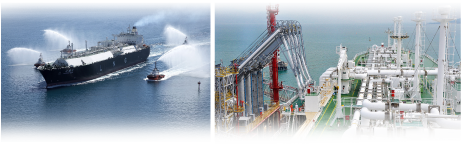LNG is natural gas – mainly methane – liquefied by reducing its temperature to -163 degrees Celsius. This reduces its volume by a factor of about 600, making it possible to transport it by tanker, in insulated tanks.

Like any hydrocarbon, LNG is a fuel (when re-gasified) and needs to be handled with care – just like oil and oil products. LNG is carried at or near its boiling point, at atmospheric pressure, and is not pressurised. Therefore “boil-off” of gas occurs naturally in LNG tanks. In most LNG ships, including CLSICO’s, the boil-off gas is used to power the ship.
LNG released to atmosphere will evaporate to produce natural gas vapour. This will not ignite even if there is an ignition source until it is further mixed with air to a ratio of between 1 in 7 and 1 in 20 gas to air. In practice this means that if there is a leak of LNG, and if it ignites, the seat of the flame will travel back to the source of the leak and burn at a constant rate until extinguished or until starved of gas. LNG on water will initially float and then vaporise rapidly. The gas is lighter than air and disperses rapidly.
LNG ships are similar in their overall configuration to crude oil tankers but in view of the very low cargo temperatures must use specialised materials for the tanks, pipes, valves and pumps required to load, store and discharge the LNG. They also employ specialised systems and rigorous procedures to manage the boil-off gas.
LNG ships therefore use more sophisticated technology and are significantly more expensive than oil tankers – about twice the price of a Very Large Crude Carrier (with similar overall dimensions). As the “capital ships’ of the tanker world, they are typically very well maintained and operated to the highest standards.
The industry has a proud safety record. LNG has been transported and consumed worldwide as a source of clean energy for more than 50 years. Only a few minor incidents have occurred during that time – with no incidents leading to loss of LNG cargo from tanks.
Reflecting the high demand for cleaner burning hydrocarbons, LNG shipping has experienced dramatic growth during the early part of the 21st century. In 2000, there were about 120 LNG ships worldwide: the 400th LNG ship will be delivered during 2014.The industry’s biggest challenge – and opportunity – is to develop a new generation of LNG shipping experts, at sea and ashore, to manage this growth.
To find out more, go to the website of the Society of International Gas Tanker and Terminal Operators (SIGTTO). Click to Learn More.

